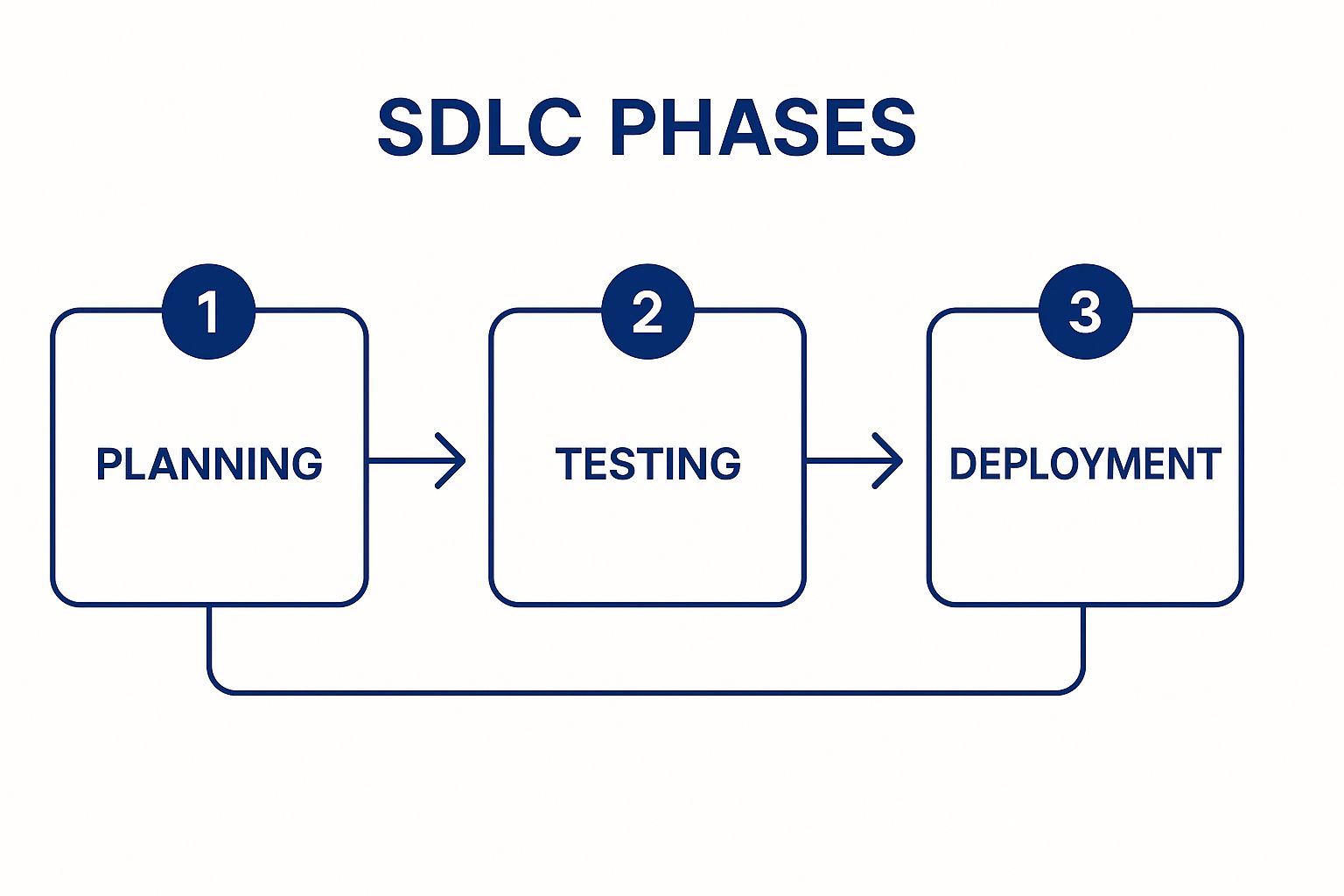Your team is busy, but are they productive? Juggling tasks with a simple to-do list or a chaotic spreadsheet often creates more problems than it solves. Key steps get missed, handoffs are fumbled, and accountability becomes a guessing game. This lack of structure isn't just inefficient; it actively undermines your team's ability to deliver high-quality results consistently. The solution lies in moving beyond basic task management and embracing structured, repeatable processes.
This is where a robust sample workflow document becomes a strategic asset. It’s more than a checklist; it’s a detailed blueprint that defines every step, role, and dependency required to complete a project successfully. It transforms abstract goals into a concrete, actionable plan that anyone on your team can follow.
In this article, we will break down six powerful workflow document examples, from agile software development to content creation. We won't just show you templates; we will dissect the strategy behind each one, providing you with tactical insights and actionable takeaways. You will learn precisely how to adapt and implement these proven structures to eliminate ambiguity, enhance collaboration, and drive predictable success for your own projects. Let's dive in.
1. Kanban Workflow Document
Originating from Toyota's hyper-efficient production system, the Kanban method is a visual powerhouse for managing work. It transforms complex processes into a clear, interactive board, making it one of the most intuitive and powerful sample workflow document formats available. At its core, a Kanban workflow document isn't just a to-do list; it's a dynamic system for visualizing work, limiting work-in-progress (WIP), and maximizing efficiency.
The system uses boards, columns (representing stages), and cards (representing tasks) to provide a real-time snapshot of your entire workflow. This visual clarity is its greatest strength, allowing teams to instantly identify bottlenecks, reallocate resources, and ensure a smooth, continuous flow of work from start to finish. It’s a favorite among agile development teams at companies like Spotify and Microsoft, but its principles are universally applicable to marketing, content creation, and beyond.

Strategic Analysis: Why Kanban Excels
The magic of Kanban lies in its "pull" system. Instead of tasks being pushed onto the team, team members pull new tasks from the backlog only when they have the capacity. This simple rule, enforced by Work-in-Progress (WIP) limits, prevents overburdening and the resulting chaos of context-switching.
Key Strategic Insight: By setting explicit limits on how many tasks can be in any "Doing" column, Kanban forces teams to focus on completing work, not just starting it. This dramatically reduces cycle times and increases throughput, a core principle that drove Toyota's manufacturing success.
This approach promotes a culture of "stop starting, start finishing." It shifts the focus from being busy to being productive, ensuring that value is delivered to the end-user consistently and predictably.
Actionable Takeaways & Replicable Strategy
To implement a Kanban workflow document effectively, you don't need a complex system. Start simple and iterate.
- Define Your Stages: Begin with a basic three-column layout: To Do, In Progress, Done. As your process matures, add more specific stages like "Design," "Review," or "Ready for Launch" to accurately map your team's real-world workflow.
- Set Realistic WIP Limits: This is non-negotiable. Calculate your team’s capacity and set a limit on the "In Progress" column. A good starting point is 1-2 tasks per team member. This discipline is the engine of Kanban's efficiency.
- Visualize Everything: Use color-coding on cards to denote priority (e.g., red for urgent), task type (e.g., blue for bug fixes), or a specific project. This adds another layer of at-a-glance information.
- Conduct Regular Stand-ups: Hold brief, daily meetings around the board. The focus should be on flow: "What's blocking our cards from moving to the next column?" This keeps the entire team aligned and proactive.
For digital implementation, tools like Trello, Jira, or Microsoft Azure Boards offer powerful, pre-built Kanban templates that make adopting this workflow seamless.
2. Software Development Life Cycle (SDLC) Workflow Document
For projects demanding precision, predictability, and rigorous quality control, the Software Development Life Cycle (SDLC) workflow document stands as the definitive blueprint. This is a highly structured, systematic approach to building software, outlining every phase from initial conception to final deployment and ongoing maintenance. An SDLC document defines the specific stages, required deliverables, review gates, and quality assurance checkpoints, ensuring a disciplined and transparent development process.
Unlike more fluid methodologies, the SDLC is built on a foundation of formal processes and detailed documentation. It’s the gold standard for high-stakes environments where failure is not an option, such as in the development of NASA’s mission-critical space software, Oracle's robust enterprise systems, or secure banking platforms at institutions like JPMorgan Chase. This detailed framework provides a clear roadmap for every stakeholder, minimizing ambiguity and maximizing quality. To gain practical insights into implementing structured processes, exploring various Jira workflow examples can serve as an excellent blueprint for optimizing your Software Development Life Cycle.
This process flow visualizes the core linear progression of the SDLC, highlighting the distinct gates between the Planning, Testing, and Deployment phases.

The visualization underscores the sequential nature of a traditional SDLC, where each phase must be formally completed and approved before the next begins.
Strategic Analysis: Why SDLC Excels
The strategic power of the SDLC lies in its emphasis on upfront planning and risk mitigation. By forcing teams to meticulously define requirements, architecture, and testing protocols before a single line of code is written, it systematically de-risks the entire project. This front-loaded effort prevents costly downstream changes and ensures the final product aligns perfectly with initial objectives.
Key Strategic Insight: The SDLC operates on the principle of "measure twice, cut once." Its rigid phase-gate structure acts as a quality control mechanism, ensuring that flaws are identified and rectified early in the cycle, which is exponentially cheaper than fixing them post-launch.
This deliberate, methodical pace is crucial for industries where compliance, security, and reliability are paramount. It fosters a culture of accountability and thoroughness that is essential for delivering complex, large-scale systems.
Actionable Takeaways & Replicable Strategy
Implementing a robust SDLC workflow document requires discipline and a commitment to process. Here’s how to apply its principles:
- Tailor Phases to Your Project: While classic models include phases like Planning, Requirements, Design, Development, Testing, Deployment, and Maintenance, adapt them. For smaller projects, you might combine Design and Development. The key is to define clear entry and exit criteria for each stage.
- Implement Rigorous Version Control: All artifacts, from requirement documents to code and test plans, must be under strict version control (e.g., using Git). This creates an auditable history and prevents confusion.
- Conduct Formal Phase-Gate Reviews: At the end of each phase, hold mandatory review meetings with all key stakeholders. Use these "gates" to formally approve the deliverables of the completed phase before green-lighting the next one.
- Integrate Automated Testing: Embed automated testing into the workflow at every possible stage, not just the "Testing" phase. This includes unit tests during development and integration tests before deployment to ensure continuous quality feedback. Improving your team's collaboration around these test results is key to efficiency.
3. Agile Scrum Workflow Document
Co-created by Ken Schwaber and Jeff Sutherland, the Agile Scrum framework is a dominant force in modern product development. It organizes complex work into structured, time-boxed iterations called "sprints," typically lasting two to four weeks. An Agile Scrum workflow document is less a static template and more a living guide that structures this entire process, detailing the roles (Product Owner, Scrum Master, Development Team), ceremonies (Sprint Planning, Daily Stand-up, Sprint Review, Sprint Retrospective), and artifacts (Product Backlog, Sprint Backlog).
This framework is built for adaptability and rapid feedback. By focusing on delivering a potentially shippable increment of the product at the end of each sprint, Scrum allows teams to inspect and adapt their plan regularly. It thrives on transparency, empirical feedback, and incremental progress. This iterative approach has been central to the success of tech giants like Salesforce and Netflix, enabling them to innovate quickly while responding to market changes.

Strategic Analysis: Why Scrum Excels
Scrum's power is rooted in its time-boxed, iterative cycle. The sprint acts as a container that creates intense focus and a predictable rhythm for the team. This fixed duration forces difficult decisions about what is truly valuable and achievable, preventing scope creep within the sprint and ensuring consistent delivery of value.
Key Strategic Insight: Scrum excels by prioritizing a "working software" increment over comprehensive documentation. Each sprint concludes with a tangible outcome that can be reviewed by stakeholders, creating a tight feedback loop that is essential for building the right product.
This focus on tangible, incremental delivery de-risks large projects. Instead of a single "big bang" launch, value is delivered piece by piece, allowing for course correction and ensuring the final product aligns with user needs, not just initial assumptions.
Actionable Takeaways & Replicable Strategy
Implementing a Scrum-based sample workflow document requires discipline and a commitment to its core principles.
- Groom the Product Backlog: The Product Owner must constantly prioritize and refine the product backlog. A well-groomed backlog, with clearly written user stories and estimated effort (using story points), is the foundation of effective sprint planning.
- Protect the Sprint: Once a sprint begins, the work committed to is locked in. The Scrum Master must protect the team from outside distractions and new requests to ensure they can focus and meet their sprint goal.
- Embrace the Ceremonies: Don't skip the meetings. Daily Stand-ups keep the team synchronized, Sprint Reviews gather crucial stakeholder feedback, and Retrospectives are vital for continuous process improvement.
- Define "Done": Create a clear, shared "Definition of Done" for all work. This ensures everyone on the team has the same understanding of what it means for a task to be complete, eliminating ambiguity and ensuring quality.
Organizations like the Scrum Alliance and Scrum.org provide extensive resources and certifications for teams looking to master this highly effective workflow.
4. Business Process Management (BPM) Workflow Document
Moving beyond individual projects to organizational-wide efficiency, the Business Process Management (BPM) workflow document is a holistic framework for optimizing entire operational systems. It's a systematic approach that documents, analyzes, and continuously improves the core processes that drive a business. A BPM workflow is not just a flowchart; it's a comprehensive blueprint detailing process maps, performance metrics, and governance rules.
This methodology forces a company to look at itself as a collection of interconnected processes rather than siloed departments. The goal is to eliminate waste, reduce errors, and create predictable, high-quality outcomes at scale. It's the engine behind legendary operational excellence at companies like Toyota with its lean manufacturing and General Electric's Six Sigma implementation, proving its power to transform complex business operations. A well-crafted BPM sample workflow document is the key to unlocking this level of strategic efficiency.
Strategic Analysis: Why BPM Excels
The power of BPM lies in its cycle of continuous improvement and its data-driven nature. It isn't a one-time fix but an ongoing discipline. By meticulously mapping a process, setting clear Key Performance Indicators (KPIs), and then monitoring performance, organizations can make objective, evidence-based decisions for optimization rather than relying on guesswork.
Key Strategic Insight: BPM's core philosophy is that you cannot improve what you do not measure. By creating a standardized, documented process, you establish a performance baseline. Every future change can be measured against this baseline, ensuring that "improvements" are genuine and contribute directly to strategic goals like cost reduction or customer satisfaction.
This methodical approach turns abstract business goals into tangible, step-by-step actions. It transforms chaotic, ad-hoc activities into a fine-tuned machine where every part works in concert to deliver value efficiently and consistently.
Actionable Takeaways & Replicable Strategy
To implement a BPM workflow document, focus on creating clarity and establishing a rhythm of review.
- Map High-Impact Processes First: Don't try to boil the ocean. Start by documenting a single, high-value process that is frequently used or is a known pain point. Use tools like Lucidchart or Visio to create a clear visual map.
- Involve the Stakeholders: The people who execute the process daily are your best source of information. Involve them directly in the documentation phase to ensure the map reflects reality and to gain their buy-in for future changes.
- Define Success Metrics: For each process, establish clear KPIs. For an invoicing process, this could be "Average Time to Payment." For customer support, it might be "First-Contact Resolution Rate." These metrics make improvement measurable.
- Establish Regular Review Cycles: A BPM document is a living document. Schedule quarterly or semi-annual reviews with the process owners to analyze performance data, identify new bottlenecks, and iterate on the workflow. This ensures continuous optimization.
5. Content Creation and Publishing Workflow Document
In the world of digital marketing, consistency is king, and a Content Creation and Publishing Workflow Document is the blueprint for achieving it. This structured process guides a piece of content from a fledgling idea all the way through to publication and performance analysis. It’s a vital tool for any team, from HubSpot's inbound marketing machine to Buffer's social media content engine, ensuring that every article, video, or post aligns with brand standards and strategic goals. This sample workflow document standardizes the entire lifecycle, turning chaotic creative energy into a predictable, high-performing content pipeline.
This workflow defines every stage: content planning, creation, internal review, stakeholder approval, publishing, and post-launch measurement. By mapping out these steps, teams can eliminate ambiguity, speed up production, and maintain a high standard of quality across all digital channels. It’s the operational backbone that allows brands to scale their content efforts without sacrificing quality or coherence.

Strategic Analysis: Why a Content Workflow Excels
The core advantage of this workflow is its transformation of content from a purely creative pursuit into a strategic business function. It establishes a repeatable system that guarantees quality control and alignment at every touchpoint. No more last-minute scrambles or off-brand messaging; every step is deliberate and measured. For a deeper dive into streamlining your content processes, consider exploring an effective content creation workflow to see how these systems operate in practice.
Key Strategic Insight: By systemizing the review and approval process, this workflow document drastically reduces feedback loops and revision cycles. It creates a single source of truth that clarifies roles, deadlines, and expectations, empowering creators to work with autonomy while ensuring final output is strategically sound and brand-compliant.
This approach builds a scalable content engine. Instead of reinventing the wheel for every blog post, the team follows a proven path, freeing up mental energy to focus on what truly matters: creating valuable, engaging content for the audience.
Actionable Takeaways & Replicable Strategy
Implementing a robust content workflow is about creating clarity and efficiency. Start with these foundational steps.
- Define Clear Stages: Map out your entire process from start to finish. A common flow is: Ideation > Outline > Drafting > Editing > Design/SEO Review > Final Approval > Scheduling > Publishing > Promotion & Analysis.
- Establish a Style Guide: Create a comprehensive brand style and tone guide. This document is the ultimate reference for writers and editors, ensuring consistency in voice, grammar, and formatting across all content.
- Use Content Templates: Develop templates for common content formats like blog posts, case studies, or social media updates. This not only saves time but also enforces structural consistency and ensures all necessary elements are included. You can learn more about mastering these creative processes with field-tested strategies.
- Leverage a CMS with Workflow Features: Use tools like WordPress, HubSpot, or a dedicated platform like CoSchedule. These systems allow you to build your stages directly into your content management environment, automating handoffs and tracking progress visibility.
6. Customer Support Ticket Resolution Workflow Document
In the world of customer service, consistency is king. A Customer Support Ticket Resolution Workflow is a structured, repeatable process that ensures every customer inquiry is handled efficiently, professionally, and in line with company standards. This vital sample workflow document maps the entire journey of a support ticket, from the moment it’s created until it is successfully resolved and closed. It's the operational backbone for delivering exceptional service.
This workflow eliminates guesswork and empowers support agents by defining clear steps for ticket categorization, prioritization, escalation paths, and communication protocols. It's a system designed to manage chaos, turning a potentially frantic queue of requests into an orderly, measurable process. This approach is the standard for service-first companies like Zappos and is embedded into the very architecture of platforms like Zendesk and Salesforce Service Cloud.
Strategic Analysis: Why a Ticket Resolution Workflow Excels
The core strength of this workflow is its ability to standardize quality and efficiency at scale. It transforms customer support from a reactive, ad-hoc function into a proactive, data-driven operation. By defining every stage, from initial response to final resolution, it creates predictable outcomes and measurable performance metrics.
Key Strategic Insight: This workflow operationalizes empathy. By setting clear Service Level Agreements (SLAs) for response and resolution times, it ensures that no customer feels ignored. The system forces a focus on timely, effective solutions, which is the most tangible way a company can demonstrate that it values its customers' time and business.
This systematic approach also creates a powerful feedback loop. Analyzing ticket data, such as common issues or escalation patterns, provides invaluable insights for product improvement and process optimization, turning the support department into a strategic asset.
Actionable Takeaways & Replicable Strategy
Implementing a robust ticket resolution workflow is crucial for any business that interacts with customers. Start with a clear and simple framework.
- Categorize & Prioritize Ruthlessly: Define clear ticket categories (e.g., "Billing," "Technical Issue," "Feature Request") and priority levels (e.g., "Low," "Normal," "High," "Urgent"). This enables smart routing to the right agent and ensures critical issues are addressed first.
- Establish Clear SLAs: Define and monitor your Service Level Agreements. What is your target first-response time? What is the maximum time for resolution? These metrics are non-negotiable for maintaining service quality and customer trust.
- Build a Knowledge Base: Create a comprehensive, internal knowledge base or FAQ. This empowers agents to find answers quickly and ensures consistent responses. It also serves as the foundation for a customer-facing help center, reducing ticket volume.
- Define Escalation Paths: Not every agent can solve every problem. Clearly document the process for escalating a ticket to a senior agent, a technical team, or management. This prevents tickets from getting stuck and frustrating customers. You can learn more about leveraging customer feedback to refine these and other processes.
Workflow Document Comparison Matrix
| Workflow Document | Implementation Complexity 🔄 | Resource Requirements ⚡ | Expected Outcomes 📊 | Ideal Use Cases 💡 | Key Advantages ⭐ |
|---|---|---|---|---|---|
| Kanban Workflow Document | Low to moderate; easy to implement | Minimal tools; digital boards recommended | Continuous task flow; visual progress tracking | Software dev, marketing campaigns, customer support | Visual, flexible, quick bottleneck identification |
| SDLC Workflow Document | High; requires detailed planning | Extensive documentation and QA resources | Structured, predictable delivery; high reliability | Large, complex software projects | Predictability, risk reduction, traceability |
| Agile Scrum Workflow Document | Moderate to high; needs trained team | Dedicated roles and ceremonies | Rapid iterative delivery with continuous feedback | Dynamic software development with changing requirements | Adaptability, collaboration, frequent improvements |
| BPM Workflow Document | High; complex initial setup | Significant documentation and analysis | Standardized, optimized business processes | Organizational process improvement, compliance | Efficiency, quality, data-driven decisions |
| Content Creation & Publishing Workflow | Moderate; multi-stage coordination | Multiple tools for CMS, design, analytics | Consistent, high-quality content with performance data | Marketing teams, digital publishing | Brand consistency, collaboration, measurable results |
| Customer Support Ticket Workflow | Moderate; system integration needed | CRM/helpdesk software and knowledge bases | Faster resolution, consistent service quality | Customer service centers, IT support | Accountability, improved response, knowledge sharing |
From Document to Dynamic: Activating Your Workflow
We've journeyed through a diverse landscape of sample workflow document examples, from the visual clarity of Kanban to the structured precision of the SDLC. Each template, whether for Agile Scrum sprints or detailed Business Process Management, offers more than just a format; it provides a strategic framework for transforming chaotic processes into predictable, high-performance systems. The goal isn't just to create a document, but to build a dynamic engine for efficiency and growth.
The power of a well-crafted sample workflow document lies in its ability to serve as a single source of truth. It aligns teams, clarifies responsibilities, and exposes hidden bottlenecks before they derail your projects. As we analyzed, the most effective workflows aren't rigid instruction manuals. They are living blueprints that adapt to your team's unique rhythm and challenges.
Synthesizing Your Strategy: Core Takeaways
To truly harness this power, let's distill our key insights into actionable principles:
- Clarity Over Complexity: The best workflow documents prioritize immediate understanding. Whether through visual columns in a Kanban board or clear stage gates in a content creation pipeline, the primary goal is to ensure anyone can grasp the process at a glance.
- Define Roles and Handoffs: Ambiguity is the enemy of efficiency. Every example we explored, from customer support tickets to software development, succeeded by explicitly defining who is responsible for what and precisely when a task moves to the next person or stage.
- Incorporate Feedback Loops: Static processes become obsolete quickly. The most resilient workflows, like those in Agile methodologies, have built-in mechanisms for review, feedback, and continuous improvement. Your document should be a catalyst for iteration, not a barrier to it.
Activating Your Blueprint: Your Next Steps
Moving from theory to practice is where the real value is unlocked. Don't let these insights remain on the page. Take decisive action now to implement what you've learned and start seeing tangible results in your team's productivity and output quality.
- Select Your Starting Point: Choose one process within your team that is causing friction or confusion. Is it your content publishing schedule? Your bug-fixing protocol? Start with a single, high-impact area.
- Adapt, Don't Just Adopt: Take the relevant sample workflow document from this article as your foundation. Customize it to fit your team's specific tools, terminology, and culture. A generic template is a starting line, not a finish line.
- Implement and Iterate: Introduce the new workflow document to your team. Schedule a check-in after one or two cycles to gather feedback. What's working? Where are the new bottlenecks? Adjust the document accordingly.
Ultimately, mastering the art of the workflow document is about installing a system of operational excellence. It's the strategic backbone that supports creative, technical, and business objectives, freeing your team to focus on innovation instead of process chaos. To fully activate your workflow and streamline operations, exploring the top document workflow software solutions available can be immensely beneficial, helping you digitize and automate these powerful blueprints.
Ready to integrate powerful QA and feedback cycles directly into your development workflow? BugSmash provides the visual feedback and bug reporting tools to make your QA process seamless, ensuring every step of your workflow document is backed by crystal-clear communication. Streamline your bug-fixing process and ship better products faster with BugSmash.




